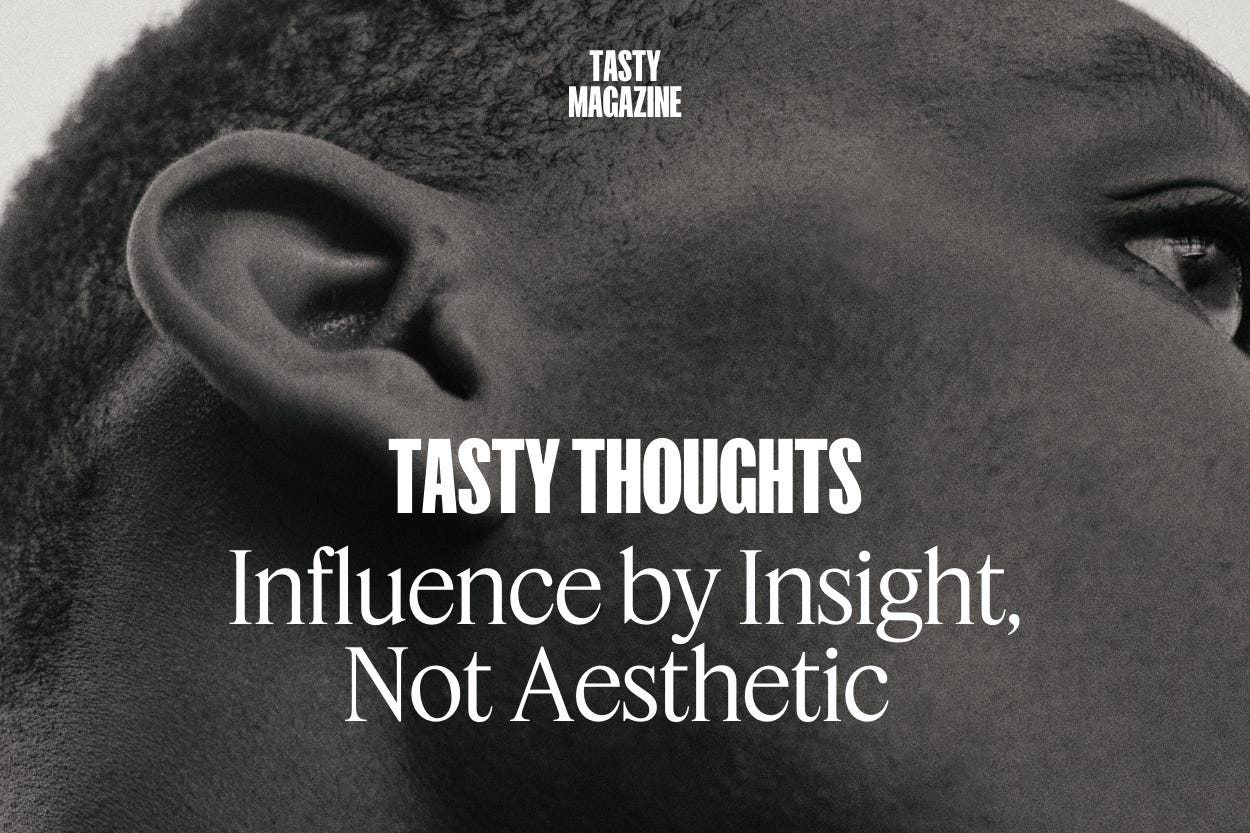TASTY THOUGHTS: Influence by Insight, Not Aesthetic
The age of aesthetics is giving way to an era of authority—where insight, not image, shapes influence.
A few weeks ago, I realised I hadn’t bookmarked a beauty haul in months. Not because I was trying to spend less—but because I’ve been gravitating toward a different kind of content. Less affiliate links, more analysis. Less aesthetics, more authorship.
The feeds I keep returning to aren’t the loudest or most algorithmically polished. They’re slow-burn thinkers: newsletter writers, niche strategists, researchers, and founders who’ve become—maybe accidentally—the new influencers.
It feels like a shift is happening. Influence is still influence, but it’s being redefined. It’s no longer just about reach or relevance. It’s increasingly about recognition. And that recognition is coming from knowledge, not just narrative.
From personal brands to intellectual ecosystems
In a 2024 report by The Business of Fashion, analysts noted that while the creator economy is booming (now valued at $250B+ globally), trust in traditional influencer formats is dipping—especially among Gen Z and millennial audiences. The saturation is real. We’ve seen every version of “what I eat in a day,” every dupe list, every GRWM from Paris Fashion Week.
But people still want to follow. We’re just looking for different kinds of voices.
This explains the quiet rise of people like:
Ana Andjelic, a sociologist-turned-CMO who writes about brand value, luxury codes, and social capital.
Diana Verde Nieto, co-founder of Positive Luxury, who contextualises sustainability beyond surface-level metrics.
Elizabeth Goodspeed, whose Casual Archivist newsletter doesn’t just show you visuals—it teaches you how to see them.
Julieta Dexter, whose LinkedIn presence has become a masterclass in building agency IP.
These aren’t traditional creators. But they’re influencing how teams make decisions, how brand decks are written, and how campaigns are judged.
They’ve become taste-shapers by way of thought. And their audiences aren’t passive fans—they’re practitioners. Builders. Strategists. People in the room.
This isn’t a pivot to academia. It’s a pivot to precision.
What sets these voices apart is their clarity—the ability to name something we’ve all been sensing. In a way, they’ve become the new cultural translators. Not selling you more. Just helping you see more clearly.
This is especially visible in spaces like:
LinkedIn, which—despite its awkward UX—is becoming a real-time lab for thought leadership. It rewards ideas with grip, not gloss.
Substack, where creators are building multi-dimensional, hybrid platforms: think B2B insight meets quiet luxury, with editorial flair.
Private communities like Geneva or Slack groups, which function as micro-networks of influence—where ideas move before they hit the surface.
These voices don’t optimise for virality. They optimise for value density. Sometimes that’s a single sentence that gets screenshotted 40 times. Other times, it’s a framework that becomes the quiet backbone of a deck a strategist presents to a CMO next week.
Influence built on insight
These new influencers don’t need daily OOTDs. They don’t need dance challenges. What they do need is the ability to:
Synthesise complex ideas
Spot patterns before they’re obvious
Say less, but with more intention
Mix disciplines—pulling from fashion, behavioural science, economics, and tech
Create compounding insight: the more you read them, the more useful they become
They’re trusted because they’re practiced. If the last generation of influence was about the fantasy, this one is about the framework.
And perhaps most notably, they’re not obsessed with being perceived. Which is rare. And refreshing.
Influence is moving from personality to perspective
When The New York Times profiled “finfluencers” last year, they found that the most successful ones weren’t the most entertaining—they were the most useful. That same pattern is repeating across industries.
The people shaping opinion now are doing it through sharp thinking, contextual clarity, and informed interpretation. They’re not just reacting to the moment—they’re often ahead of it.
So what does this mean if you’re building something?
Whether you’re a designer, founder, creative consultant, or advisor—it’s worth asking:
Do I actually share what I know, or just what I like?
Am I trying to build a following, or a point of view?
Am I okay being found by fewer people—if they’re the right people?
This kind of influence doesn’t always come with massive followings. But it often leads to deeper relationships, better clients, and stronger business models.
In fact, many of the most respected operators I know today don’t post often. But when they do, people pay attention. Their influence isn’t in the frequency—it’s in the calibre.
What’s next?
Expect to see more of:
Hybrid influencer-thinkers: people who write, consult, design, and create—without being boxed in by one identity
Publishing-as-brand: Substacks and micro-media properties that become extensions of personal expertise
Taste as strategy: where your ability to notice and name becomes more valuable than your ability to perform or promote
In other words: smart is stylish again.
And that’s good news for people who’ve been quietly thinking for years.
Thanks for reading Tasty.
If this resonated, I’d love to know which “quiet experts” you’re currently following. Reply or drop them in the comments—always here to learn.









